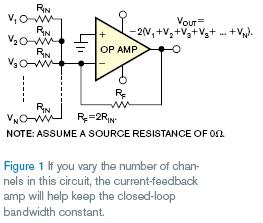電壓和電流反饋放大器應(yīng)用電路的結(jié)構(gòu)一般相同,除了幾個(gè)關(guān)鍵點(diǎn)。
電流反饋比電壓反饋放大器有更高的轉(zhuǎn)換速率。像這樣,電流反饋比電壓反饋放大器能更好的解決高速問(wèn)題。“電流反饋放大器”的名字帶有一些神秘色彩,但一般電流反饋和電壓反饋放大器應(yīng)用電路的結(jié)構(gòu)是一致的,除了幾個(gè)關(guān)鍵點(diǎn)。
首先,電流反饋放大器電路的反饋電阻值必須保持在小范圍內(nèi)。電阻值越低,電流反饋放大器的穩(wěn)定性越差。可以在電流反饋放大器產(chǎn)品手冊(cè)中找到規(guī)定的電阻值。電壓反饋放大器的反饋電阻值更寬。放大器的驅(qū)動(dòng)能力限制了電阻的最小值,全電路噪聲限制電阻最大值。
圖1顯示了適于電流或電壓反饋放大器的電路。如果反饋電阻RF等于2RIN,其中RIN為輸入電阻,各通道的閉環(huán)增益為–2V/V。乍看,容易假設(shè)閉環(huán)帶寬與增益帶寬積除以各通道的增益相等,或|–2V/V|。但千萬(wàn)別做這個(gè)假設(shè)!

如果使用如圖1電路中電壓或電流反饋放大器,噪聲增益為:
![]()
其中,N為輸入通道數(shù)。帶電壓反饋放大器的電路帶寬等于增益帶寬積除以噪聲增益。例如,如果使用180MHz增益帶寬積的電壓反饋放大器,三個(gè)輸入通道(N=3),增益–2V/V,電路閉環(huán)帶寬為25.7 MHz。額外的通道減少閉環(huán)帶寬,即使輸入信號(hào)持續(xù)達(dá)到–2V/V的增益。
如果使用如圖1電路的電流反饋放大器,放大器閉環(huán)帶寬較少的依靠閉環(huán)增益和輸入通道數(shù)。如果用這樣的放大器設(shè)計(jì)電路,首先應(yīng)該挑選合適的反饋電阻,各廠商的規(guī)格和電路噪聲增益。然后選擇合適的RIN值。從這一點(diǎn),如果電路增加通道,或許將發(fā)生信號(hào)帶寬和增益劇增的微小變化。如果那個(gè)情形出現(xiàn),退回并確定反饋電阻的選擇。對(duì)電流和電壓反饋放大器,噪聲增益通常與公式1的結(jié)果相等,但減少電流反饋放大器電路的反饋電阻值,使電路帶寬增加。
英文原文:
Voltage- and current-feedback amps are almost the same
The application-circuit configurations for voltage- and current-feedback amps are generally the same, except for a few key points.
By Bonnie Baker -- EDN, 10/25/2007
Current-feedback amplifiers have a higher slew rate than do voltage-feedback amplifiers. As such, current-feedback amps can better solve high-speed problems than their voltage-feedback counterparts. The name “current-feedback amp” carries some mystique, but, generally, the application-circuit configurations for voltage- and current-feedback amps are the same, except for a few key points.
First, the feedback resistor of a current-feedback-amp circuit must stay within a small range of values. Lower value resistors reduce the current-feedback amp’s stability. The feedback resistor’s higher values reduce the current-feedback amp’s bandwidth. You can find the prescribed feedback-resistor value in the current-feedback amp’s product data sheet. The voltage-feedback-amp’s feedback-resistance value is more forgiving. This amplifier’s drive capability limits the resistor’s minimum value, and the overall circuit noise limits the maximum value.
Figure 1 sho ws a circuit that is appropriate for either a current- or a voltage-feedback amp. If the feedback resistance, RF, equals 2RIN, where RIN is the input resistance, the closed-loop gain of each channel is –2V/V. At first glance, it is easy to assume that the closed-loop bandwidth equals the gain-bandwidth product divided by each channel’s gain, or |–2V/V|. Don’t make this assumption!
If you use a voltage- or current-feedback amp with the circuit in Figure 1, the noise gain is:
where N is the
number of input channels. This circuit’s bandwidth, with a voltage-feedback amp, equals the gain-bandwidth product divided by the noise gain. For instance, if you have a voltage-feedback amp with a gain-bandwidth product of 180 MHz and there are three input channels (N=3) at a gain of –2V/V, the circuit’s closed-loop bandwidth is 25.7 MHz. Additional channels reduce the closed-loop bandwidth, even though the input signals continue to see a gain of –2V/V.
If you use a current-feedback amp with the circuit in Figure 1, the amplifier’s closed-loop bandwidth depends less on the closed-loop gain and the number of input channels. If you design this circuit with such an amp, you would first pick the optimum feedback resistor, per the manufacturer’s specification and the circuit’s noise gain. You would then select the appropriate value for RIN. From this point, if you add channels to the circuit, a small variation in the signal bandwidth and gain peaking in circuit may occur. If that scenario is a concern, go back and refine your feedback-resistor selection. For both current- and voltage-feedback amps, the noise gain always equals the result of Equation 1, but you can reduce the feedback-resistor value with the current-feedback-amp circuit and get an increase in circuit bandwidth.

